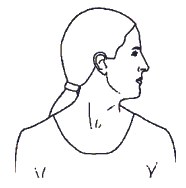Neck pain
Sudden onset neck pain is common. Two out of three of us will have neck pain at some time in our life. In most cases it is not due to a serious disease or structural problem and often the exact cause of the pain is not clear.
What is the cause of neck pain?
Non-specific neck pain is very common
This is sometimes called ‘simple’ or ‘mechanical’ neck pain. Often the exact cause is not known. It may include minor strains and sprains to muscles or ligaments in the neck. Bad posture may be a contributing factor in some cases. For example, neck pain is more common in people who spend much of their working day at a desk, with a ‘bent-forward’ posture.
Acute (sudden onset) torticollis
This is sometimes called a ‘wry neck’. A torticollis is when the head becomes twisted to one side and it is very painful to move. It may be due to a minor strain or sprain to a muscle or ligament in the neck. It is common for people to go to bed feeling fine and to wake up the next morning with an acute torticollis. The pain usually eases and resolves over a few days without any treatment.
‘Whiplash’ jolt
A ‘whiplash’ jolt to the neck, most commonly due to a car accident, may cause neck pain. This can be very distressing due to the nature of the injury. Thankfully, our necks are resilient and serious injury rarely occurs. Often there is considerable muscle spasm to protect your neck, which can be very painful and make it difficult to move. However, research shows that early movement is the best treatment.
Degeneration
Degeneration (‘wear and tear’) of the vertebrae (spinal bones) is a common cause of persistent neck pain in older people. This is called cervical spondylosis. Most people over the age of 50 have some degree of spondylosis, often without any symptoms.
Cervical radiculopathy
Cervical radiculopathy is when a nerve is irritated in the cervical (neck) region. As well as neck pain, there may be symptoms such as numbness, pins and needles, pain and weakness in parts of an arm supplied by that nerve.
When should you go to A&E?
On rare occasions you may need to seek emergency attention for your neck pain especially if:
- You have had a significant injury such as a major road traffic accident or a serious sporting injury
- You have neurological symptoms such as dizziness, headache, double vision, slurred speech, swallowing difficulties or numbness of weakness of your face or limbs
- You have had a collapse
- You have a history of cancer, particularly if your neck pain is worse at night
What tests do you need?
In most cases you will not need any further tests. A full clinical examination carried out by a doctor or physiotherapist is much more accurate at diagnosing your neck problem. The majority of imaging scans will be negative and do not quicken your recovery.
When should you see your GP?
You should seek GP attention if your neck pain is continually affecting your sleep and daily activities. Your GP can refer you for physiotherapy.
How to treat your neck pain
Self-help measures are the initial treatment for most neck pain.
- Use simple pain relief like paracetamol or ibuprofen as it is important to control your pain to allow you to move more easily—if your pain is persisting, see your GP about prescribing stronger painkillers
- Try gentle exercises within comfort to maintain range of movement of your neck—gentle exercise increases blood flow to the tissues and promotes healing
- Try hot packs over the muscles in your neck and shoulder area to reduce muscle spasm
- Reduce activities that aggravate your pain, and allow your neck to rest—avoid heavy lifting and repetitive tasks and address any issues at work that may be irritating your neck
- Place a rolled up towel in the base of your pillow to provide a support for your neck whilst you sleep
- Have a positive and realistic outlook as your neck pain will get better but may take some time, with good and bad days—pace yourself and do not overdo it by setting unrealistic goals on the way to recovery at home and work
Neck exercises
It is important to maintain as much range of movement in your neck as possible to prevent it from becoming stiff, and to promote tissue healing. The exercises below should be performed gently, within pain limits, increasing the movement as pain allows.
 |
Gently turn your head to one side until you feel a stretch but keep within pain free limits. Repeat to other side. Repeat approximately 10 times. |
 |
Tilt your head towards one shoulder until you feel the stretch on the opposite side. Using your hand gently pull your head further to the side. Hold approx 5–10 seconds. Repeat to other side. |
 |
Pull your chin in, keeping your neck and back straight (not tipping your head forwards). Hold at the end position and feel the stretch in your neck. Repeat approximately 10 times. |
Further information
Further general advice and information is available on the following websites:

